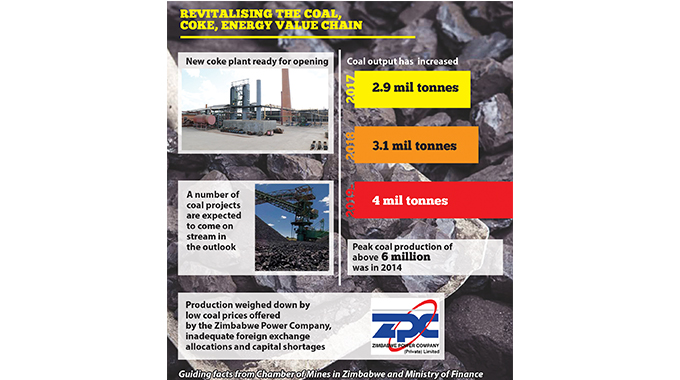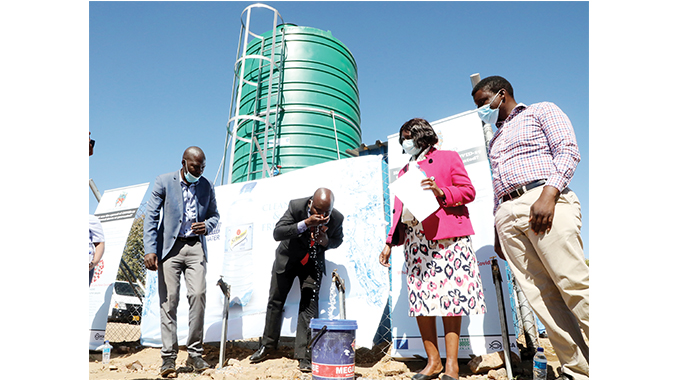Coal to fuel economy – Export focus and value addition to create more jobs

Prosper Ndlovu, Business Editor
THE coming in of new players in the coal sector has seen the country up its output in the last few years with increasing focus now anchored on value addition and exports.
Given its vast coal deposits and other natural resources, Matabeleland North province is primed for major economic transformation as more investors venture into coke production, which is a lucrative element of coal exploitation with higher potential for increased export earnings and downstream economic gains.
Previously dominated by Hwange Colliery Company Limited (HCCL), the sector now has ruthless competition as new players seek a share in supplying the domestic and export market where they also tussle with regional producers.
HCCL now competes with Makomo Resources, Zambezi Gas, South Mining and Liberation Mining. The significance of the coal industry to the economy comes under spotlight this week with President Mnangagwa expected to visit Hwange tomorrow and Friday to explore its operations and officially open South Mining New Coking Project. He will also tour other coal mining companies and assess power generation projects.
“This is a historic moment to have the President (Mnangagwa) visit us for two days. We are excited by this as it shows the importance of the sector and leadership will understand our operations better,” said Mr Raymond Mutokonyi, who chairs the Coal Producers Association.
“Coal is critical the energy generation side of the economy. We are a serious enabler to the industry and it is exciting that we have seen a number of players coming on board in the last few years and they are established now.
“We are focusing on value addition now through coke production, which we export and expect to get more forex for the economy.”
As the coal value chain industry expands, Mr Mutokonyi said Hwange and the entire province and the economy at large, were poised to reap a huge dividend in terms of job creation and a vibrant service industry due to a wider scope for increased disposable incomes.
He said exporting presents more opportunities for increasing capacity utilisation for the sector, which would lay a solid ground for revival of support industries in transport and spare parts manufacturing.
Hwange-born businessman and economic analyst, Mr Morris Mpala, said revitalising the coal and energy value chain was strategic for the entire economy.
He said the coal mining dividend for Matabeleland North was also augmented by the diversity of tourism attraction centres whose investments stand to equally benefit from the coal value chain.
“Value addition of coal should be the norm. Coking coal is the future in that it has many by products for different industries such as fertiliser producers, tar for road construction and steel manufacturing among others. These highlight the significance of the black gold to the economy of this country,” said Mr Mpala.
“With these investments, expectation is on increased employment, export proceeds, technology and skills transfer. What we need is a shared valued model that allows a win-win scenario to say ‘how do locals get involved via their investment vehicles and Govt initiated schemes’.
“Value addition critical and at the same time we seek smart production, which is environmentally friendly. Our coal can still be sustainably exploited to aid power generation despite growing global campaigns against it.”
Matabeleland North Provincial Affairs Minister Richard Moyo has said the President’s will activate the province to do more in terms of speeding up the implementation of developmental projects and spur economic growth.
According to the Chamber of Mines Zimbabwe, coal output increased from 2.9 million tons in 2017, to 3.1 tons in 2018. The positive trajectory continued in 2019 at a projected four million tons.
The Chamber has noted that a number of coal projects are expected to come on stream in the outlook with new investors such as Sunlight Energy, RioZim, among other projects expressing interest.
However, industry players have said they are being weighed down by low coal prices offered by the biggest sole consumer, Zimbabwe Power Company, inadequate foreign exchange allocations and capital shortages.
Of major concern to new entrants are the high Special Grant fees that are reported to be a major barrier to the execution of projects. The high fees have also affected the oil and gas sector that is still in its infancy.
President Mnangagwa and his delegation have a hectic schedule ahead as indicated in the tentative programme for the tour.
To kickstart his visit tomorrow, the Head of State will get a briefing on the coal and hydrocarbons sector overview at Western Areas before the tour and ground-breaking ceremony. After the tour, President Mnangagwa will officially launch the South Mining New Coking Project after which he will visit JinAn/Tutu Coking Coal Project and Hwange Colliery Company’s Chaba Mine.
On Friday, the President will tour Dinson Colliery, ZZCC Coke Plant, Zambezi Coal and Gas Mine and Makomo Resources. He will wrap up his visit by touring the US$10 million 300MW Zimbabwe ZhongXin Electric Energy (ZZEE) power plant where a signing ceremony will be conducted. Once complete, the ZZCC coal-driven power station on the outskirts of Hwange, will contribute 300MW into the national grid. The project is being done in phases of 50MW with the first phase to be completed in October 2020.
On completion the power plant will consume 300 000 tonnes of coal annually and ZZCC has applied to Government for a Coal Special Grant (CSG) in order to enjoy economies of scale once the firm starts producing coal to support its operations.










Comments